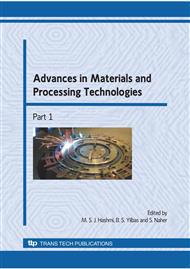[1]
L. Jones et al, ITER vacuum vessel sector manufacturing development in Europe, in: Fusion Engineering and Design, Vol. 75-79 (2005), pp.607-612.
DOI: 10.1016/j.fusengdes.2005.06.308
Google Scholar
[2]
L. Jones et al, Results from ITER vacuum vessel sector manufacturing development in Europe, in: Fusion Engineering and Design, Vol. 82 (2007), p.1942-(1947).
DOI: 10.1016/j.fusengdes.2007.05.005
Google Scholar
[3]
L. Jones et al, Towards advanced welding methods for the ITER vacuum vessel sectors, in: Fusion Engineering and Design, Vol. 69 (2003), pp.215-220.
DOI: 10.1016/s0920-3796(03)00341-7
Google Scholar
[4]
F. Boitout and J.M. Bergheau, The numerical simulation of welding in Europe: present capabilities and future trends, in: Trans JWRI, Vol. 32, N° 1 (2003), pp.197-206.
Google Scholar
[5]
J. Guo, P. Le Masson, E. Artioukhine, T. Loulou, P. Rogeon, M. Carin, D. Carron, M. Dumons and J. Costa, Thermal process modelling and computer simulation, in: Journal de Physique IV, Vol. 120 (2004), pp.279-290.
DOI: 10.1051/jp4:2004120032
Google Scholar
[6]
M. Carin, P. Rogeon, D. Carron, P. Le Masson and D. Couedel, Numerical simulation of electron beam welding simulation and instrumental technique, in: Revue Européenne des Elements Finis, Vol. 13, N° 3-4 (2004), pp.247-267.
DOI: 10.3166/reef.13.247-267
Google Scholar
[7]
J. Guo, P. Le Masson, S. Rouquette, T. Loulou and E. Artioukhine, Estimation of a source in a two-dimensional heat transfer problem: application to an electron beam welding, theoretical and experimental validations, in: Inverse Problems in Science and Engineering, Vol. 15, N°7 (2007).
DOI: 10.1080/17415970701198688
Google Scholar
[8]
S. Gallée, P.Y. Manach and S. Thuillier, Mechanical behavior of a metastable austenitic stainless steel under simple and complex loading path, in: Materials Science and Engineering A, Vol. 466, Issue 1-2 (2007), pp.47-55.
DOI: 10.1016/j.msea.2007.02.054
Google Scholar
[9]
P.J. Armstrong and C.O. Frederick, A mathematical representation of the multiaxial Bauschinger effect, in: CEGB Report, RD/B/N 731 (1966).
Google Scholar
[10]
J.B. Leblond, D. Pont, J. Devaux, D. Bru and J.M. Bergheau, Metallurgical and mechanical consequences of phase transformations in numerical simulations of welding processes, in: Modelling in Welding, Hot Powder Forming and Casting, chapter 4, edited by Pr. Lennart Karlsson, ASM International (1997).
Google Scholar
[11]
J. Devaux, G. Mottet, J.M. Bergheau, S. Bandhari and C. Faidy, Evaluation of the integrity of PWR bi-metallic welds, in: ASME J. Pressure Vessel Tech., Vol. 122 (2000), pp.368-373.
DOI: 10.1115/1.556194
Google Scholar
[12]
B. Souloumiac, F. Boitout and J.M. Bergheau, A new local-global approach for the modelling of welded steel component distortions, in: Mathematical Modelling of Weld Phenomena, Vol. 6 (2002), pp.573-590.
Google Scholar
[13]
F. Faure, J.M. Bergheau, J.B. Leblond and B. Souloumiac, New methods for numerical simulation of welding of large thin structures, in: Revue Européenne des Eléments Finis, Special Edition Numerical Simulation of Welding, Vol. 13, N° 2-3 (2004).
DOI: 10.3166/reef.13.289-311
Google Scholar


